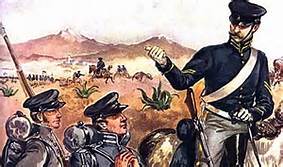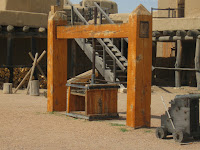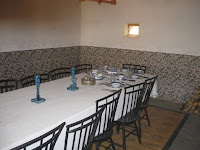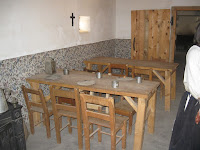
Potential Market for Elephants- I think they could live comfortably part of the year on tall Prairie grass and scrub, but the average winter temperature is in the 40’s and most of the summer and fall the streams are undependable.
Date of My Visit: Sept 9, 2015
History: For over sixty years before the railroads took over the
 |
| 1830's |
Santa Fe trail from Independence, Missouri to Santa Fe, Mexico was an important part of America's economy. At the beginning there were almost no white settlements on the route.
 |
| The Santa Fe Trail Ran Here |
Envision having spent several weeks nursing your oxen and mules on a grassy trail in an area were the streams are very undependable.
 Then you come up one last bluff and over the tall prairie grass looms a giant adobe castle with the U.S. flag flying overhead. As your head wagon pulls up to the main gate a man comes out with a pitcher of clean water. cooled with chips of ice!
Then you come up one last bluff and over the tall prairie grass looms a giant adobe castle with the U.S. flag flying overhead. As your head wagon pulls up to the main gate a man comes out with a pitcher of clean water. cooled with chips of ice!
The fort, more of a castle since it is fortified but also a residence, was built in 1833 on the Arkansaw river, then the Mexican-American Border, by two brothers Charles and
 |
| Arkansaw River and Bent's Fort |
William Bent and their partner Cernan St. Vrain. They positioned it to service trade trains going both ways on the dry northern or mountain route. They were also in the right place to deal with fur trappers from the Rockies and trade with the southern plaines tribes.
William set up their business in Taos with St. Vrain, married into an important Mexican family and made regular trips to St. Louis to arrange supplies. Charles took charge of the fort and relations with the Native Americans.
 |
| Charles Bent |
He established an especially close relationship with the Southern Cheyenne, first saving two boys from traditional enemies, and then marrying Owl Woman. She was the daughter of White Thunder, keeper of the Cheyenne Medicine arrows, the sacred symbol of the tribe. They seem to have had a strong marriage and he took her younger sisters as co-wives.
 |
| Owl Woman |
William was once struck by a serious infection while living in the Cheyenne camp and his throat became filled with pus. Owl Women had to feed him broth through a quill. His faith in the Cheyenne was such that he allowed a shaman named Lawyer to treat him. Lawyer strung a handful of sand burs on a piece of animal tendon. The burs had stiff barbs and when the tendon was forced down Bent’s throat and drawn out it pulled a quantity of slothing flesh with it. Bent was able to breath, swallow and eventually regained his strength.
The market in beaver furs dropped badly about the time the fort opened. However a new market for buffalo hides was opening. A few trappers were able to switch to being professional hunters but most of the hides were brought in by the Cheyenne and Arapaho.
By the late 1840’s the Bents had a
commercial empire who’s influence stretching from the current Canadian border to the Rocky Mountains and south into Mexico. They imported goods from Europe and the Orient (pepper and tea especially) for sale as luxuries.
However in the 1840’s the United States prepared to alter the political face of the whole continent.
Texas, after winning its independence from Mexico, had joined the U.S. The expansionist elements in the United States saw a chance to use a conflict over the border of Texas and Mexico to start a war. They could seize not only the disputed territory but California and its seaports.
In 1846 U. S. troops and later militia units used the fort as a staging area. Taos and Santa Fe were seized almost without resistance by American troops, possibly aided by bribery to the Mexican authorities there. William Bent was appointed governor of the New Mexico territory.
Of course the war interrupted all trade through Bent’s Fort, especially since the large numbers
 |
| Mexican American War Dragoons |
of troops contaminated the water holes and their animals stripped the land. In 1847 a Mexican civilian uprising killed Charles Bent and a number of other authorities appointed by the U.S. army The resistance temporarily held Taos and US troop that had moved on to Mexico and California had to be recalled.
The Cheyenne were preparing to leave because they had killed off most of the buffalo, when in 1849 they were struck with a terrible cholera epidemic killing off over a third of their population. Owl Woman had died in 1847, but Bent’s mother-in-law died during the epidemic.
William Bent and St. Vrain attempted to get reimbursed by the army for use of the fort and failing that tried to sell it to the military. Finally in 1849 Bent set up a new trade center about 40 miles downriver. His remaining wives and children chose to stay with their tribe, but visited. By 1853 he had finished Bent’s New Fort, this one built of stone, which was later purchased by the army.
He died in Kansas City in 1869, still running a shipping company, but is buried in Las Animas, Colorado not far from both forts that bore his name.
The structure standing today is a recreation. Shortly after being deserted the original seems to have been destroyed either by an accidental fire, or Indians, or possibly blown up by Bent in a fit of pique. The remains of the fort were used to shelter a stagecoach station and later as a corral.
In 1950 the Colorado State Historical Society acquired Bent’s Old and New Forts. In 1960 it was designated a National Historic Landmark by Congress and in 1976 the reconstruction of the fort was completed. It is now maintained by the National Park service.
The reconstruction was based on archeological finds and the reports of many visitors.
 |
| Painting of River and Fort by Abert |
Especially useful were sketches, drawings and paintings by Lt. James Abert who visited in 1845.
 |
| One of Abert's sketches |
In the published report of his assigned reconnaissance of the southwest Abert describes the fort as “composed of a series of rooms… forming a hollow square, with the entrance on the east side. A round tower on the left…and another diagonally opposite… constitute the flanking arrangement. “
He observed the outer walls were nearly two feet thick and had pierced loop holes four feet above the flat roofs where gunners could knee and fire while sheltered.
 |
| View from Tower, with cannon. |
The entire structures was built of “adobes” sunburnt brick composed of clay and cut straw, which no attacker could set fire to.
 |
| corral. |
There was a stone corral on the west side to protect animals.
 |
| Rest Room |
My Visit: I found the fort on CO 194 between La Junta and Las Animas Colorado. When you arrive the first thing you see, beside the sign, is a rest room. Its half buried architecture is a reminder that many homes used to be built that way on the prairie. In fact it’s posted as a tornado shelter.

One can walk slightly less than a quarter mile or use a phone at the rest room to summon a golf cart to pick one up. You get to experience a restored section of prairie grassland and then get the effect of the flag and fort appearing out of nowhere.
After viewing the film on the trading post's history I was the only visitor to choose to have a guide take me around the fort. My guide was a young lady dressed in a long skirt and loose embroider blouse wearing a knife with a deer antler handle. I imagine her appearance was close to that of a Mexican woman of the era.
Our first stop was the courtyard. The giant cork screw is a press for changing piles of buffalo
 |
| Cannon in lower right |
hides into easily transported bales. The cannon wasn’t for show it’s aimed right through the door.
In some ways the center of the fort was the Trade Room where barter or an exchange of credit paid for furs, buffalo hides, and sometimes goods from Mexico.
One thinks in terms of guns and powder but copper cooking wear was popular.
The Native Americans sometimes cooked in buffalo stomachs. Fill one with hot rocks, then pour in stew and let it cook till the
 |
| Buffalo stomach |
rocks cool. Naturally these didn’t last long and durable copper wear was a welcome replacement along with metal tools, needles and thimbles. You try sewing with bone needles or thorns.
 |
| Fancy side |
 |
| Ordinary side |
The Dining room was were the social distinctions among the staff and guest were clearest. On one side of the room was a table with table cloth, silver, candles, and porcelain for the owners and honored guests. At the other tables was pewter for the regular customers.
The worker’s mostly ate in their rooms or the kitchen.
 |
| Hearth |
Cooking was done here on the large limestone hearth, where you spread hot coals and then placed the iron wear on it. When archeologists found the kitchen the hearth was still complete and smooth.
 |
| Starting a Fire |
The recreator who gave me my tour is here demonstrating starting a fire with flint and tinder.
The kitchen was mostly run by Bent’s slave Charlotte, but Mexican and Indian women were sometimes hired to help. The cuisine went from Mexican to rough frontier food to semi-formal dinners.
For a few months in 1845 a Mrs. Dale worked there. She had escaped after being kidnapped by Pawnee in a raid a few days east of the fort, on her way to Independence. Believing her husband and pre-teen son had been killed she hoped to earn her way home. Then her son, who had been rescued and adoped by some American traders, stopped by the fort. Their story was so moving the frontiersmen contributed travel money for them and a caravan going to St. Louis took them for free.
Evenings the dining hall would be cleared and democracy took over as dancing would take place. Charlotte was a much sought after partner when the harmonic and squeeze box came out.
The secret of the fort’s construction was the adobe, because of the lack of lumber. Mexican workers knew how to mix clay, water, sand and straw to create bricks in areas with little stone or wood. The 18x9x4 inch bricks after drying in the sun became fairly durable when covered with an adobe plaster. The wood that supported the roofs had to be floated down river from the mountains, the small trees found on the prarie like the cotton wood were unsuitable for load bearing.
 |
| Drain |
The original walls would have needed regular repair. Today an epoxy is sprayed on them at regularly. There are drains for the rainy season.
At lease thirty employees were on staff during the fort’s busy years. Mexicans maintained the walls, herded sheep, and trained horses and oxen. Most of the skilled workman, carpenters, coopers, blacksmiths etc., were American.
The second floor was mostly quarters for the doctor, clerks and guests like Lt. Abert and Susan Magoffin a pregnant woman who had to stay there for several weeks.
 |
| Second floor bedroom |
Mrs. Magoffin was shocked that gambling was so common noting the fort was equipped with a billiard room, a race track, and a cock fighting arena. She also complained about the behavior of her servants, and the need to constantly moisten the dirt floors to cut down on dust. While she tried to rest she wrote the constant noise in the yard of "the shoeing of horses, neighing, and braying of mules, the crying of children, the scolding and fighting of men are all enought to turn my head. "
Both she and Lt Abert had a chance to observe a number of Native Americans visitors. Three 'Arrapaho' indians were pointed out to Mrs. Magoffin as probable spies. I was surprised to find that large numbers of Indians were allowed to visit the fort at the same time. It would seem unsafe but there are many sketches of large groups inside the fort at the same time.
 |
| Cheyenne Ceremony in fort 1848 |
It was a rough neighborhood as Mrs. Dale's experience proved. A shepherd was murdered while working there and the killer was never caught. However there seems to be no record of an actually attack on the fort.
Today there is an excellent book store and a shop that offers some good historical recreations, knives etc. in the fort, along with water and bathrooms.
The nature trail running along the Arkansas River is only of interest to serious students of plant life, but I may have seen a Spotted Plains Leopard Frog.
Geek Factors- Bent’s fort is an important part of the novel Flashman and the Redskins an episode in George McDonald Fraser’s fictionalized history of the 19th century through the eyes of his creation cowardly, greedy, selfish General Harry Flashman of Her Majesties Army.
The recreated Fort was used in the CBS western miniseries The Chisholms (1979–1980) and briefly appeared in the1998 CBS mini-series Lonesome Dove.
References
Williams, Felicia, Roadside Geology of Colorado Mountain Press, Missoula, Mt, 2014 ISBN 9780878426096
Bent’s Old Fort National Historic Site A Self-Guiding Tour, National Park Service , U.S. Department of the Interior
Dick, Everett (editor) Tales of the Frontier University of Nebraska, Lincoln, NB, 1970 ISBN 0803257449
Zinn, Howard A People’s History of the United States, Harper Collins, New York, NY 2003 ISBN9780060528423
Abert, James, Expedition to the Southwest: an 1845 Reconnaissance of Colorado, New Mexico, Texas and Oklahoma , University of Nebraska Press, NB , 1999 ISBN 9780803259355
Magoffin, Susan Shelby , Down the Santa Fe Trail and into Mexico , University of Nebraska Press, Lincoln , 1982, ISBN 9780803281165




 Then you come up one last bluff and over the tall prairie grass looms a giant adobe castle with the U.S. flag flying overhead. As your head wagon pulls up to the main gate a man comes out with a pitcher of clean water. cooled with chips of ice!
Then you come up one last bluff and over the tall prairie grass looms a giant adobe castle with the U.S. flag flying overhead. As your head wagon pulls up to the main gate a man comes out with a pitcher of clean water. cooled with chips of ice!










